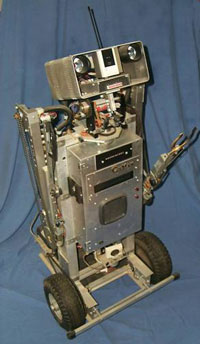

I considered some design parameters before I started. The base drive had to be strong enough to negotiate more than just a flat tile floor. It had to be able to transition over a door threshold and small obstacles. The overall 'foot print' had to be small enough to navigate door openings and hallways. It had to be stable enough not to easily tip over. I also decided to limit the number of axis of movement. For every axis there has to be a motor, an encoder, limit switches, and related mechanical hardware. Without the battery, CyMan was pushing ninety pounds.
There were also cosmetic considerations. I was determined that my project was not going to look like a box with wheels. So far, no one who has seen it has asked, "What is it?" At 45 inches tall, CyMan has a strong stable chassis made from aluminum cable tray. Most of the motors are gear reduced 12v DC. The drive tires are 10" pneumatic with a rear 5" caster. A 12-volt gel cell located in the drive base for stability provides the main power. Two arms (each with a 32" reach) have three motors each, shoulder, elbow, and hand. Each arm can easily lift 7 pounds. One arm has a vertical hand, and the other a horizontal grasp. The head has two motors for pan/tilt and holds a BW camera with microphone. Also in the head is a TV transmitter. Lights for the eyes and mouth were added for show.
Three Iota Systems processor boards provide control using the 80C32. One board has the optional date/time chip. Custom interface boards provide signals to the motor drives and from the sensors. Sensors consist of optical switches for travel limits and optical encoders for position. Three custom made motor driver boards each can drive four motors.
MosFet transistors in an H configuration provide 99.9% power. If you short out these puppies you can weld the wire or motor. Another custom board provides output to stepper motors and other devices and is home for the Polaroid Sonic ranging module. The sonar module is located above the wheels and can pan approximately 270 degrees. Ranging is from 12'' to 20 ft. in one-inch increments. A voice synthesis board is mounted behind the front panel and can speak phonetic text sent to it.
Software was written in machine code, 8051 assembly, and 8051 basic to read the limit switches, record motion from the position encoders, and to provide PWM (pulse width modulated) drive to the motors. The motion command consisted of motor number, direction, and speed. By using PWM it can deliver full power at low speeds and pull itself over modest obstacles like a 2x4.
For safety, two main power switches are located on the front. One is for motor drive and the other for the processors and drive electronics. By leaving the motor power off it was easier to debug without being inadvertently grabbed or run over. With a battery the weight was close to 100 pounds.